Richard Branson’s Virgin Galactic and their SpaceshipTwo space plane, and Jeff Bezos’ Blue Origin with their New Shepard vehicle mark the start of a new era of human spaceflight. Both of these systems are capable of giving customers an incredible once in a lifetime experience, taking them to the edge of space and back. This will provide passengers on both vehicles approximately four minutes of weightlessness and a unique view, which less than 600 humans have ever experienced. Both Richard Branson and Jeff Bezos have decided to ride on the very first crewed flights of their company’s crafts.
What Is Suborbital Spaceflight?
The first operational commercial spaceflight from the United States was in 2020, when SpaceX took NASA astronauts Bob Behnken and Doug Hurley up to the International Space Station on their Crew Dragon spacecraft atop a Falcon 9 rocket. This was an orbital mission called DM-2 and is a completely different task than what Blue Origin and Virgin Galactic are doing. Orbital missions require a much more capable rocket than suborbital missions. Once orbital missions get their payload into orbit, it won’t come back down to Earth until it deorbits.
Suborbital spaceflight on the other hand doesn’t reach orbit, they’re just that, sub orbital; less than orbit. Compared to orbital missions, these rockets’ goals aren’t to get to orbit. They are purpose built space tourism machines. Poking fun of these rockets for not reaching orbit is like poking fun of a Honda Civic for not being able to pull as much as a semi truck. It’s not designed to do that.
The important thing is that these rides do go to space! After all, to go to space they just have to go up until they are out of Earth’s atmosphere. It’s not like the atmosphere suddenly stops, but it slowly fades away until they have reached an altitude where there’s practically no atmosphere.
Orbital VS Suborbital
Space can be defined as a lack of atmosphere, but not a lack of gravity. Gravity doesn’t stop by reaching space. At an altitude of 100 km, mass is still being pulled by Earth’s gravity with nearly the same force as at sea level. Specifically, gravity still pulls with 9.4 m/s2 of force, as opposed to the 9.8 m/s2 at sea level.
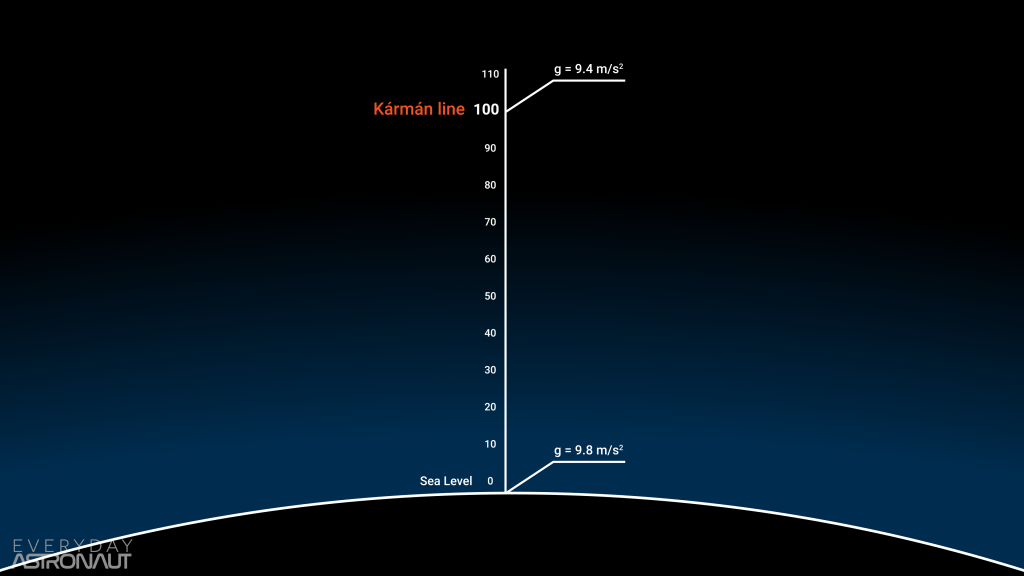
Both, Blue Origin’s New Shepard and Virgin Galactic’s SpaceShipTwo will launch more or less straight up. After about two minutes of acceleration for New Shepard and one minute for SpaceShipTwo, the engines will cut off and both vehicles will coast up, where they will hit their peak altitude or apogee, and then fall back down to Earth. At the moment the engines cut off, passengers will begin to feel weightless. Passengers will feel weightless until the spacecrafts begin to hit the atmosphere again and start to experience aerodynamic drag.

At apogee, these vehicles have virtually zero horizontal velocity. They are practically completely stationary for a brief moment in time. If they now were to try and stay in space by getting into orbit, they would need to be traveling at orbital velocities, roughly 28,000 kmh sideways, which is about 8 times faster than their peak velocity during ascent. A quick rundown on orbit vs suborbit can be found here.
Starting with engine cut off, passengers of both vehicles will experience weightlessness for three to four minutes.
Definition Of “Space”
The Kármán line is an international definition that marks the edge of space and is defined as 100 km above sea level. The US’ definition of where space begins is 80 km, which is the altitude where speeds required to generate lift are exceeding orbital velocity. By international definitions, only one of the two vehicles reaches space, although both will experience weightlessness.
Virgin Galactic’s SpaceShipTwo
Richard Branson’s Virgin Galactic is a suborbital tourism launch company that is not to be confused with Virgin Orbit. Virgin Orbit is a small satellite rocket company, which launches their LauncherOne rocket from a Boeing 747 called Cosmic Girl. At one point they both were part of Virgin Galactic, but are now separate entities. Virgin Galactic currently has one system composed of SpaceShipTwo and its carrier plane, WhiteKnightTwo.
There’s also a newer production-ready version called SpaceShip III (formerly SpaceShipThree). It is virtually the same spaceplane as SpaceShipTwo, but hasn’t flown by the time this article has been published.

SpaceShip’s Development and History
SpaceShipTwo and WhiteknightTwo are scaled up versions of the original SpaceShipOne and WhiteKnightOne, which were built by Scaled Composites and won the 2004 Ansari X prize of 10 million US dollars by successfully flying to space and back twice in just five days. This feat won the attention of Richard Branson and the Virgin Group, who were looking for a space tourism option and announced that they would license the technology and sponsor SpaceShipOne after its first powered flight.
Virgin Galactic co-founded The Spaceship Company in 2005 at a 70% ownership, with Scaled Composites owning 30%. The Spaceship Company’s goal was to scale up SpaceShipOne and its carrier plane to maximize their commercial spaceflight potential.
In 2008 the company would roll out their new WhiteKnightTwo carrier plane, which was about 3 times larger than the original WhiteKnightOne. It now features a full twin fuselage design with four jet engines.
While one side of the fuselage is a replica of SpaceShipTwo’s interior, which is used to train passengers at reasonable cost, the other fuselage can be used for cheaper trips to 18 km. At almost double the altitude of a standard airliner, passengers will be high enough to see a dark blue sky.
The first SpaceShipTwo, technically the first Scaled Composites Model 339 SpaceShipTwo, was revealed on December 7th, 2009, and was named VSS Enterprise. It sported a much larger design capable of ferrying 2 pilots and 6 passengers. On ascent it uses an upgraded version of their unique hybrid rocket engine.
SpaceShipTwo’s Hybrid Rocket Engine
The hybrid engine uses Hydroxyl-terminated polybutadiene (HTPB), a rubber based solid rocket fuel, but unlike a traditional solid rocket booster, it uses nitrous oxide (N2O) as oxidizer, which enables them to shut down the engine mid flight. This is where the “hybrid” comes from. The solid rocket propellant will only remain firing when liquid or gaseous N2O is present in the motor. This enables the pilots to light the engine with an ignitor, with N2O flowing from an oxidizer tank into the solid propellant part of the engine. Despite being able to turn the engine off, it cannot actively throttle.
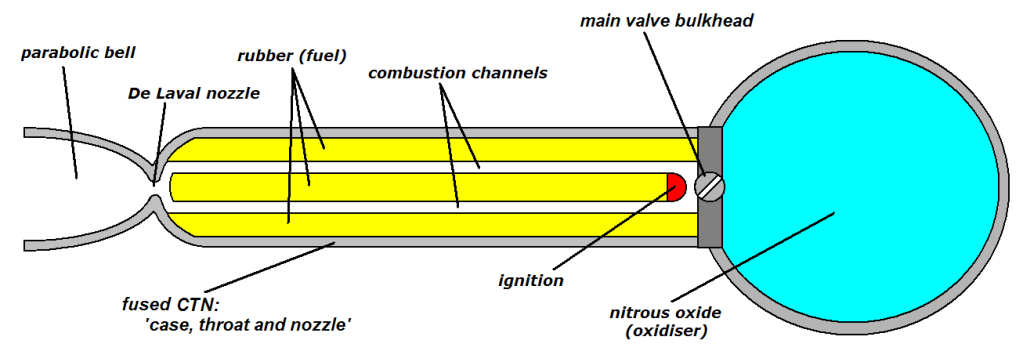
For a short period of time, Virgin Galactic explored the viability of a different solid fuel called thermoplastic polyamide with N2O and methane (CH4) for combustion, while using helium for shut down. They would switch back to using HTPB after the first and only flight with that version of the engine, which unfortunately resulted in the tragic loss of one of the two test pilots and the vehicle.
Setbacks And Tragedy
The breakup of the spaceplane was not related with the use of this new engine. The breakup was related to a staple of its design, the feathered re-entry system. The spaceplane broke up when the Co-Pilot prematurely unlocked the feather system at Mach 0.92. Aerodynamic and inertial loads opposed on the feather system overcame the feather actuators, which resulted in the breakup of the vehicle.
SpaceShipTwo Specific Characteristics
The overall shape and design of Virgin Galactic’s spaceplanes is super unique, featuring pneumatically tilted tails and horizontal stabilizers. The twin tails of the rocket plane have a so-called carefree re-entry profile, which takes inspiration from a badminton shuttlecock. This carefree re-entry profile is a passively stable design that provides a large amount of drag and makes the vehicle want to re-enter belly down every time, even in the case of it re-entering upside down.
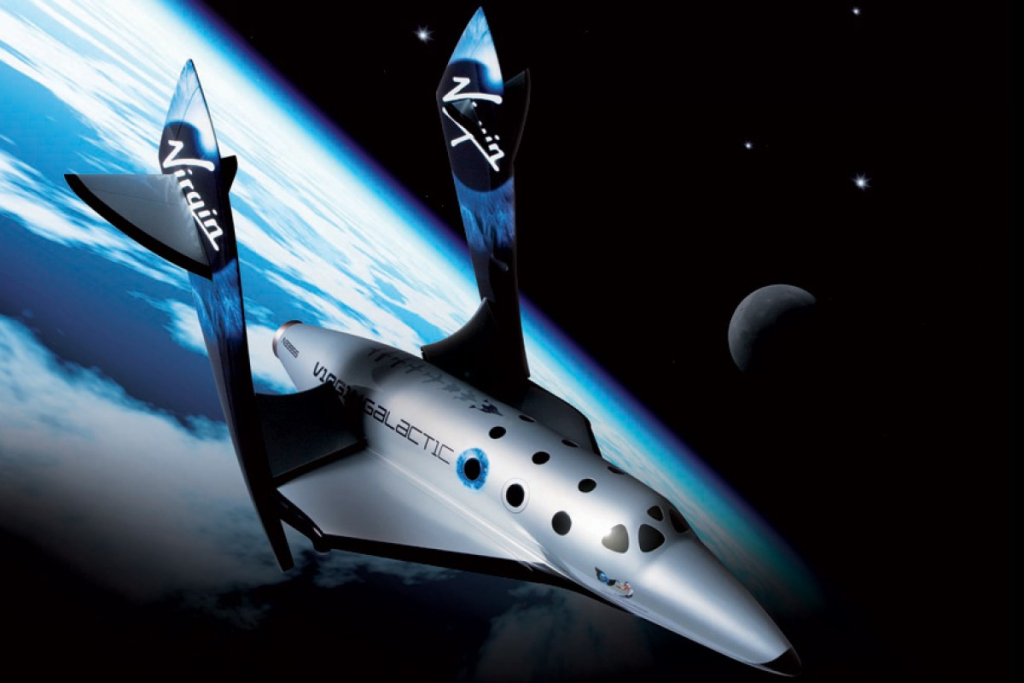
Once the vehicle is subsonic and in the lower portions of the atmosphere again, it straightens its wings back out and glides back to the runway for a relatively standard landing. Instead of a front landing gear, it uses a simple skid that also functions as a brake pad on touchdown.
Humans At The Helm
The most interesting part about these vehicles is that humans are 100% in control of them. There is no autopilot and no fly-by-wire. The pair of pilots control the vehicle directly through electronically controlled trim at supersonic speeds, and cable and rod linkages at subsonic speeds. To control the orientation of the spaceplane in space, they have 12 cold gas thrusters. Cold gas thrusters use compressed air and are a very simple and effective way of controlling the attitude of a vehicle when there is no atmosphere present. They can control pitch, yaw and roll, with a total of 6 pairs of thrusters for redundancy.
The Customer Experience
Virgin Galactic pays close attention to detail inside the vehicle and ensures the customer the best possible experience by including 16 cameras. Customers will not have to fiddle around their cameras, helping them to live in the moment and focus on the experience. There are seatback displays to help staying up to date with every phase of the flight. The seats are also dynamic and change their angle to maximize comfort and safety during the different portions of the flight. Furthermore, the seats also feature self retracting seat belts to help passengers getting out of their seats quickly during weightlessness. There are 17 windows spread across the whole spaceplane with halo edges so passengers can easily get a hold on them.
In 2016, Virgin Galactic built their second SpaceShipTwo called VSS Unity. It flew three times to space before being ready for passengers. Five years later, Virgin Galactic presented their first SpaceShip III called VSS Imagine on March 30th, 2021.
Blue Origin’s New Shepard
Jeff Bezo’s Blue Origin has been around for a long time and was even founded before SpaceX in 2000. Blue Origin’s philosophy is “Gradatim Ferociter”, which is Latin for “Step by Step, Ferociously”. Their slow and patient approach to spaceflight development certainly mirrors that.
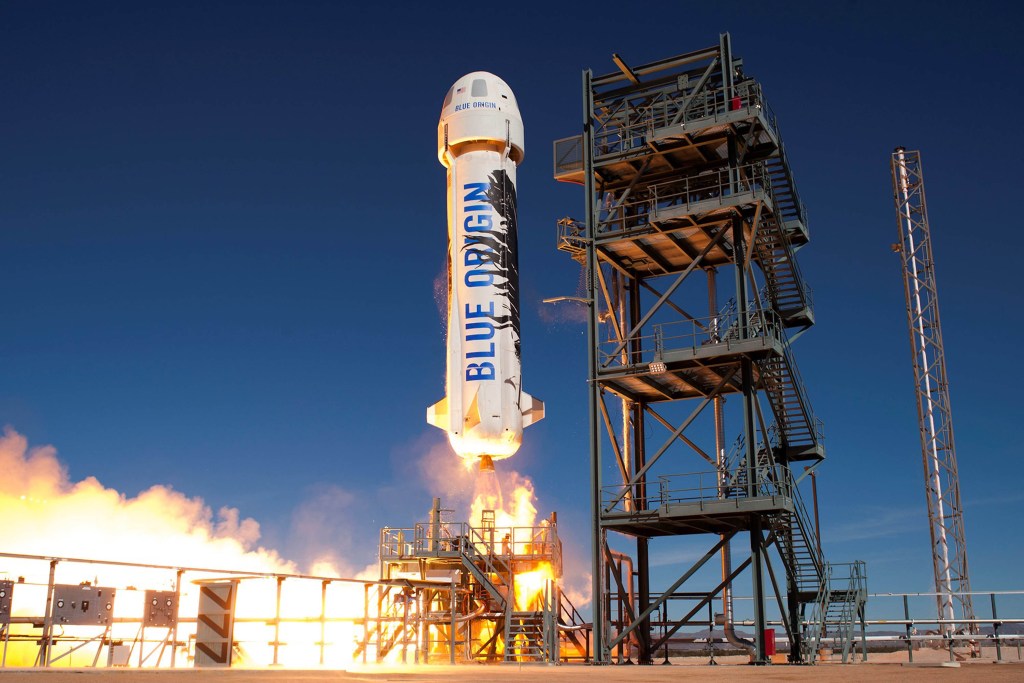
New Shepard’s History And Development
Before New Shepard saw the light of day, Blue Origin was demonstrating many technologies with a rocket powered vehicle named Goddard in 2006. After Goddard, Blue Origin began developing the New Shepard system, which is comprised of a space capsule and a booster.
New Shepard is named after Alan Shepard, the first American in space who performed a suborbital flight. Their next rocket, New Glenn, is named after John Glenn, the first American to go on an orbital flight, and as the name suggests, this rocket will be orbital.
New Shepard’s capsule was first tested at the end of 2012 with a pad escape test of their launch abort system. They demonstrated their pusher style solid rocket motor abort system and the ability to fully deploy the parachutes for a soft landing at low altitudes. The large center console looking structure in the middle of the spacecraft is actually the solid rocket motor capable of pushing the capsule away from a failed booster, aiding in the safety considerations of the vehicle.
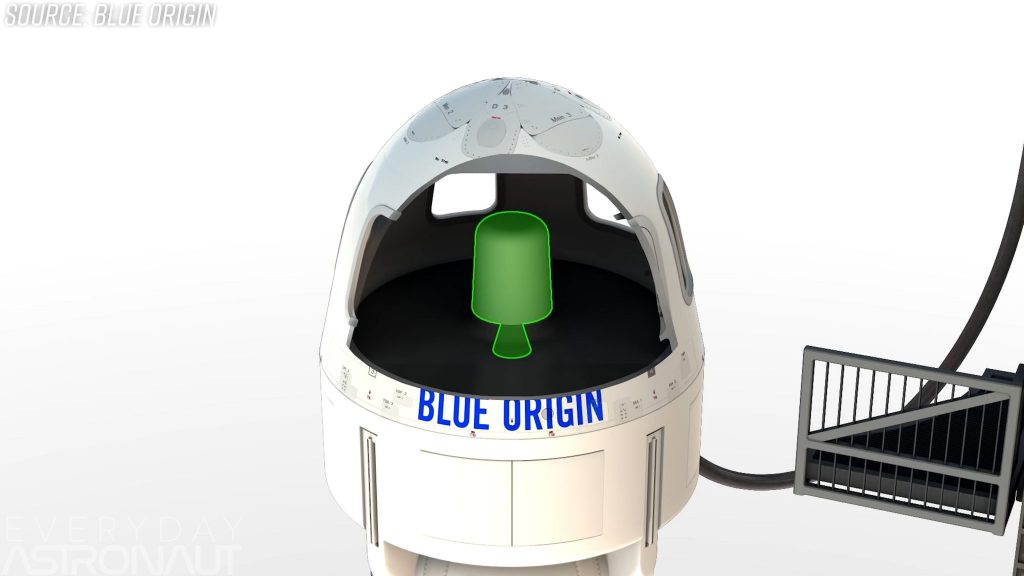
Structure And Design
The booster has a ring that the capsule sits on top of. Not only does it serve a purpose for aerodynamic stability during re-entry, but it also has reliefs for the abort motor. This means if they had to light the abort motor while attached to the booster, the hot gases from the rocket motor can escape to the side of the booster, lessening the chance of the booster exploding below it.
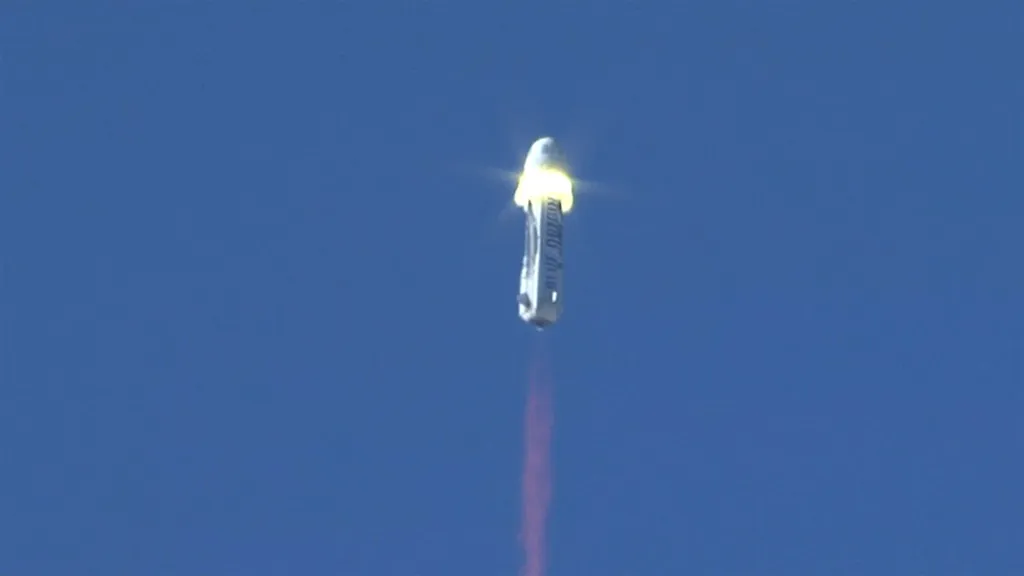
New Shepard’s BE-3 Engine
In 2015, Blue Origin announced they had completed acceptance testing of their BE-3 engine that would power the New Shepard booster. The BE-3 is a combustion tap-off cycle hydrolox powered engine. The tap-off cycle is charactarized by tapping off hot gasses from the main combustion chamber to spin the turbine to power the propellant pumps. It’s not an easy engine to start up as combustion can only occure when the pumps are running, which need combustion happening to run and so on and so forth.
The BE-3 is inefficiently splayed out on the base of New Shepard. Although the packaging isn’t tight and probably not as mass efficient, it is much easier to access the parts and potentially tweak or repair if necessary. This allows them to quickly refurbish and learn the engine inside and out, which further helps them shape their BE-3U vacuum optimized open expander cycle version that Blue Origin will utilize on their orbital New Glenn rocket in the future.
The BE-3 powers the rocket from their West-Texas launch site at about 1,200 m above sea level all the way up to about 50 km, when the vehicle hits main engine cut off and will coast the rest of the way up to space. Around 80 seconds before apogee, the vehicle stages into its two separate components, the booster and the capsule. The capsule will reenter and fall back down slower than the booster, which is skinnier with less surface area.
Heading Back Down
It’s during this portion of the mission that the booster deploys fins from the top ring to help steer it. After that it deploys some air brakes that are up around the top ring too, which further help to scrub off velocity. Then, at only about 3 km above the ground the booster re-lights its BE-3 engine to propulsively land. The engine can throttle down below 20% of maximum thrust, which allows the rocket to hover and perfectly redirect itself over its targeted landing pad. For reference, SpaceX’s Merlin engine on Falcon 9 and Falcon Heavy can throttle down to about 40%, which is also why the Falcon 9 can’t actually hover and has perform its fairly aggressive hover slam maneuver.
Early Achievements
In fact, Blue Origin’s New Shepard was the first rocket to reach space and then propulsively land. They did this about one month before SpaceX landed their first Falcon 9 booster. Of course, one rocket is an orbital rocket booster travelling up to 8,000 kmh sideways carrying a large upper stage, while the other is suborbital, reaching a peak velocity of about 3,500 km/h, traveling straight up with virtually no horizontal velocity. Although New Shepard is ‘only’ a suborbital rocket, it was and still is a noteworthy accomplishment since landing rockets that go to space is not a trivial task.
The Capsule’s Descent
Meanwhile, the capsule has a slower return due to a larger surface area and blunt body re-entry. At about 2 km it deploys three drogue chutes, followed by its three main parachutes at just about 1 km in altitude. Despite the capsule coming down at only about 25 km/h, touchdown will even be softer than that by firing retro thrusters at the very last moment to create a nice cushion of air between the capsule and the ground. This is similar and comparable to what ROSCOSMO’s Soyuz capsules do when landing. New Shepard’s capsule could actually lose two of its main parachutes and stil land slow enough to be survivable. That’s also thanks to shock absorbing seats that further help with dampening the shock.
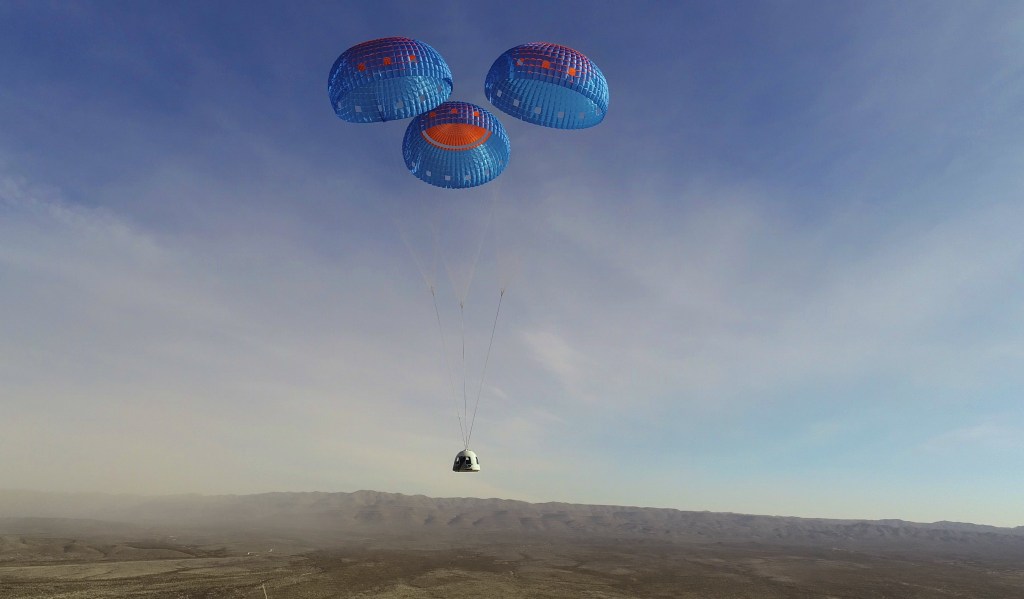
Unlike SpaceShipTwo, New Shepard is 100% autonomous. This means all six seats on board can be filled with passengers and there is no need for any of those seats to be taken up by pilots. Each of the six passengers are treated to massive windows. They are, at the time when this articles was published, the largest windows to ever fly to space, which are an important part of the passenger experience during flight.
New Shepard’s Test Program
New Shepard successfully flew 15 times before putting humans on board. They lost their first booster on their first attempt in early 2015, but still safely recovered the capsule. After that, the second booster would fly five times before being retired. The third booster and second capsule flew seven times successfully before being retired and then the fourth booster and third capsule flew twice before being ready to be the first to fly humans.
SpaceShipTwo VS New Shepard
SpaceShipTwo is 18 m long with an 8.2 m wingspan and a tail height of 4.6 m. It’s about as long as New Shepard is tall, which is 19 m and about 3.8 m wide. For reference, SpaceX’ Falcon 9 is 70 m tall while being 3.7 m wide.

The Engines
Since both vehicles sport different engines, their stats differ as well. While Blue Origin’s New Shepard sports a combustion tap-off cycle engine burning liquid hydrogen (LH2) and liquid oxygen (LOx), Virgin Galactic’s SpaceShipTwo are fitted with a hybrid rocket engine burning the solid fuel HTPB with nitrous oxide (N2O) as oxidizer. Blue Origin’s BE-3 produces about one third more thrust than Virgin Galactic’s RocketMotorTwo at 490 kN and 310 kN respectively. Since the BE-3 is a Hydrolox engine, it has a relatively high specific impulse (ISP) compared to RocketMotorTwo’s ISP at 310 s and 250 s respectively. The burn time of these engines is quite different as well, due to the fact that New Shepard launches on the ground and SpaceShipTwo launches mid air. Because of this, New Shepard’s BE-3 runs for about 2 minutes and 20 seconds compared to just about one minute for SpaceShipTwo.
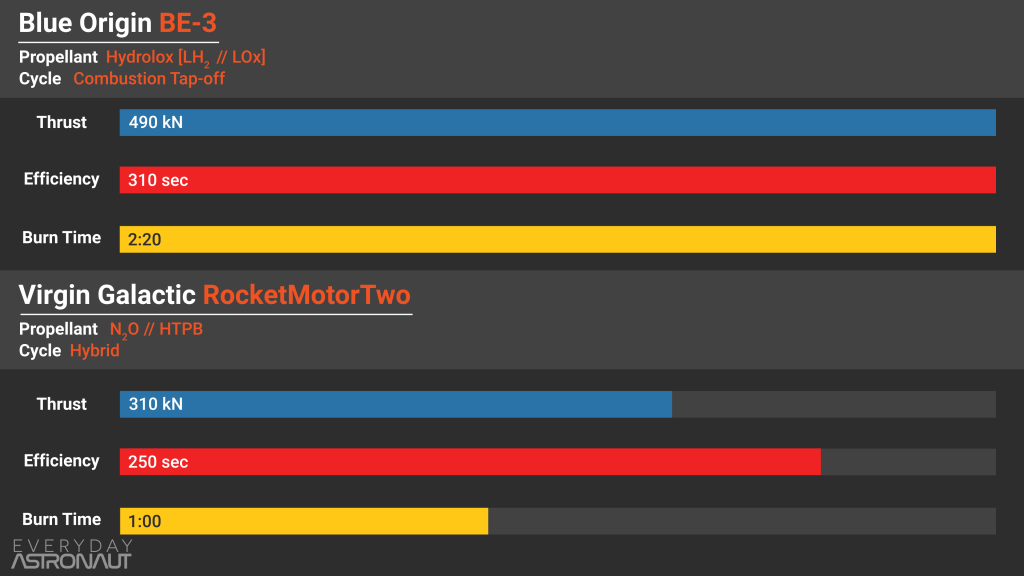
Since the BE-3 is a Hydrolox engine, it has very little environmental impact as combustion products are only water vapor. In comparison, SpaceShipTwo’s RocketMotorTwo has a rather large environmental impact as HTPB damages the Ozon layer of Earth’s atmosphere. For more information on how much rockets pollute, please check out this video and/or article.
Mission Characteristics
As mentioned before, SpaceShipTwo can carry eight people, two pilots and six passengers, while New Shepard can also carry six passengers without the need of pilots. Compared to SpaceShipTwo, New Shepard is a much shorter ride with only about ten minutes from take off to landing. SpaceShipTwo’s usual flight time is about two hours from wheels up until touchdown. A lot of that time is either the long and slow climb while being attached to WhiteKnightTwo, or the slow glide back down. Both vehicles still spend roughly the same amount of time experiencing weightlessness of around three to four minutes.
One notable difference between the two vehicles is their maximum altitude. The highest VSS Unity has ever flown is just shy of 90 km, which does mean it has never crossed the Kármán line. Even though it is rather arbitrary, and doesn’t really change anything as far as the passenger experience goes, it is worth noting. New Shepard on the other hand reaches an apogee of around 105 km.
Reusability Brings Down Cost
Another important note about these systems is that they are both fully reusable. This is vital in bringing the cost of commercial spaceflight, even suborbital spaceflight, down and opening up the experience to more people than before.
The price per ticket for both vehicles is not something that is well published yet. Most people who have paid for rides on SpaceShipTwo have paid $250,000, but unfortunately, the price of a ride on New Shepard is not public yet. So far, there is only one example of price and it’s a customer who bid $28 million dollars to fly on the first flight alongside Jeff Bezos, his brother Mark, and aviation legend Wally Funk. On a conference back in 2019, Blue Origin’s CEO Bob Smith suggest a price per ticket in the “hundreds of thousands”, with other sources saying it will be “well north of $500,000”. At the publishing date of this article, no official price has been disclosed yet.
Conclusion
Both, Virgin Galactic’s SpaceShipTwo (SpaceShip III in the future) and Blue Origin’s New Shepard offer a great passenger experience focused ride to the edge of Earth’s atmosphere, while being two totally different systems.
On the one hand, there is New Shepard’s simple booster-capsule design catapulting customers above the Kármán line and landing them under parachutes in about ten minutes. On the other, there is Virgin Galactic’s complex but elegant air launched hybrid rocket plane that will take customers on a two hour round trip to the edge of space and back again. While New Shepard sports the biggest windows that have ever been to space, SpaceShipTwo will flip upside down, allowing passengers to look back down on Earth.
At the end of the day, both systems have advantages and disadvantages over one another that will fit the personal need of different customers, but, when it comes to experiencing weightlessness, they both offer nearly the same at around three to four minutes.





You didn’t want to mention the landing experience of Virgin Galactic? Landing and taxiing back to Spaceport America, being able to walk out and into the Terminal vs Blue Origin where you land in the desert and what, get picked up in a van?
I hadn’t realized just how close the size is between SpaceShip Two and New Shepard! I thought NS was considerably larger than SS2. Must just be the “bias” of being used to very large orbital-class rockets. Looking up New Shepard compared to Mercury-Redstone, M-R also looks visually like it should be *MUCH* larger, but it isn’t.
How can the astronauts abort from the spaceship two?
They seem to wear parachutes on the images when inside SS2. But exiting may not work well in all phases and for every kind of failure 😛
Most failure modes result in gliding back to base just like with a regular aircraft, pretty much a non-event. As Freefaller said they do have parachutes, but if you need them you’re probably screwed. On the other hand a failure with a VLS such as New Shepard, Crew Dragon, or Soyuz, is a much harsher situation and if parachutes are even a question you’re probably already dead.
Both fatal SpaceShip accidents were due to lax safety culture at Scaled Composites. The irony is that the natural safety factor of the vehicle is what allowed them to get away with it for so long. Virgin Galactic had to do a fair bit of work to bring the vehicle up to spec when the problems came to light. The other vehicles have strict design requirements because of the inherently greater risk of vertical launch so they haven’t had the same problems.
Hey Tim and Team,
can you tell, whats the maximum acceleration that a passenger experiences?
I suppose with NS it’s much higher (and vertical), but whats the g-forces when SS2 fires and throttles up it’s engines?
Has someone made a diagram throughout the flights?
Thanks.
PS: Just asking for my other rich self, who want’s to buy the most bang for bucks… ah… next life.
Just learning about the environmental impacts of the Virgin Galactic flights. That could be a basis on which customers make their decision.